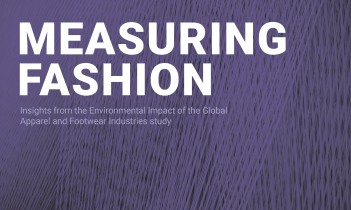If you had gone looking for our global apparel sector lead Angela Adams last week, you would have found her at the Copenhagen Fashion Summit (CFS) immersed in rich discussions among 1300 attendees (with 800 on the waiting list!). The importance of making bold commitments, data-driven decision making, and cross-sector collaboration were all on the docket as leading fashion brands, businesses, non-profits, and scientists gathered to share best practices and innovations that will accelerate the transition to a sustainable textile and fashion industry.
Following her time at CFS, Angela gives her take on the state of sustainable fashion. Here are highlights from that conversation.

“We need companies to work together to drive bold systemic change. Incremental change will no longer do. We need courageous leaders and empowered stakeholders to get there — and we all need to be held accountable for our actions.”
Angela Adams, Senior Sustainability Consultant + Global Apparel Lead, Quantis
Quantis: The Copenhagen Fashion Summit is the world’s leading business event on sustainability in fashion — what would you say was the biggest takeaway from this year’s Summit?
Angela Adams (AA): The resounding message from CFS this year, the event’s 10th anniversary, is that the industry has a tremendous responsibility to take urgent action to address environmental and social issues. The Pulse of the Fashion Industry Update released by the Global Fashion Agenda shortly before the event revealed that progress on sustainability is actually slowing.
This wake up call is great fuel for innovation and there is an ever-growing number of innovative solutions out there. But what’s really needed today are ambitious goals to move the needle. We need companies working together to drive bold systemic change, and that includes collaborating with a variety of different sectors. Incremental change will no longer do. We need courageous leaders and empowered stakeholders to get there – and we all need to be held accountable for our actions.
A growing number of fashion companies are making bold commitments and setting science-based targets. Quantis has worked with several of them already and serves as a technical and expert advisor on the Apparel and Footwear Sector Science Based Targets Guidance that will soon be released. As the momentum builds, companies need robust metrics to measure their impacts and support their reduction plans. Environmental data is a critical enabler of this transformation.
Q: Can you elaborate on the role data is playing in the apparel sector? Why is it so critical?
AA: Robust supply chain data is a growing priority for all players in the apparel sector because we need facts to drive innovation and support our sourcing decisions. Solid metrics help businesses track progress and drive meaningful change. But having reliable data in a globalized supply chain as complex as the apparel industry’s is not easy. Quantis, together with a group of industry partners, developed the World Apparel & Footwear Life Cycle Assessment Database (WALDB), a comprehensive database with robust life cycle data for single processes in apparel and footwear supply chains.
The WALDB allows companies to assess unique product and corporate footprints including innovative and recycled fibers, new technologies, new regions, and future datasets. We are looking for forward-thinking partners in the apparel and footwear sector to begin the next phase of the WALDB which we aim to launch later this year. Quantis and its partners are investing in metrics businesses can trust and benefit from, helping to solve the data challenge and enabling brands to engage their supply chain and inspire change.
Q: You mentioned the need for companies to work together to drive systemic change. What should this collaboration look like?
AA: Collaboration was another big topic at CFS. It’s clear to everyone that the environmental challenges we are facing are massive — much bigger than any one company can tackle, even bigger than what one sector alone can take on. I was excited to hear fashion leaders emphasize the need to collaborate with other companies and even other sectors.
The food sector could be an important ally in driving systemic change because the sectors share the same land-based resources and have common environmental challenges. This cross-sector collaboration is what we facilitate through multi-stakeholder initiatives such as the Accounting for Natural Climate Solutions Guidance, a game-changing resource set to transform the sustainable management of forests, soils, land, and agriculture, and the Plastic Leak Project, which tackles plastic and microplastic pollution across sectors.
Q: What resources can you recommend for people looking to understand the state of sustainable fashion?
AA: Definitely take a look at the Pulse of the Fashion Industry Update I mentioned earlier.The update revealed that progress on sustainability is not moving fast enough to counterbalance the impact of rapid growth in the industry. In fact, it’s slowing. 40% of the industry have not moved beyond the pre-phase and phase 1 of the pulse curve, meaning they’ve made no formal commitment to sustainability. At the Pulse Masterclass I participated in on May 14th, there was a lot of discussion on what could be done to get the other 40% moving. We need to educate and empower stakeholders in the value chain and look to disruptive technologies that can scale and make a true difference. Governments and investors also have a role to play. Responsibility speaks more than sustainability.
Another resource is our Measuring Fashion publication released last year. The report not only gives evidence-based insights on the environmental impact of the industry, but also focuses on three levers for action to reduce impacts: rethinking energy, disrupting to reduce and designing for the future — all of which were echoed at the CFS.
Q: Is there a moment from the Summit that is now etched into your memory, something that’s fuel for your work?
AA: We were all wowed by Paul Polman’s speech, former CEO at Unilever and now UN Global Compact Vice-Chair. He said, “to solve the issues we have today, we don’t have to send people to Mars to find the answers. We have the answers; we only need the right leadership and our willpower.” He’s absolutely right. The answers are here, ready for business leaders to respond with formal commitments, and for stakeholders to speak up and work together to drive the urgent transformation we need.
Related Pages

Page
WALDB – World Apparel & Footwear LCA Database
Quantis developed WALDB - World Apparel & Footwear Life Cycle Assessment Database, a comprehensive database with robust life cycle data for single processes in apparel...
 Report
Report By Quantis
Measuring Fashion: Insights from the Environmental Impact of the Globa...
This report delivers guidance and insights for brands and businesses committed to making changes to reduce their impacts.
